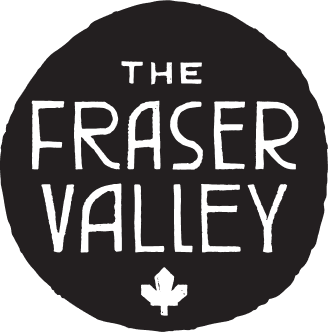It’s getting to be that time of year again – time for the splashing, thrashing, and incredible natural wonder that is the salmon run. Just as the Dogwood is BC’s provincial flower, and Western Red Cedar the provincial tree, the Pacific Salmon swam its way into the hallowed halls of BC’s official symbols, earning its designation as provincial fish in 2013. Capped off by the spawning season, this fascinating fish displays a true definition of the “circle” of life. Born in freshwater, they spend their juvenile life in streams, rivers or lakes and then migrate to the ocean where they spend their adult years, living and feeding until they have matured to the spawning stage. At this point, they circle back to the freshwater in which they were born to spawn, and in doing so, end their life cycle.

Image Credit Left to Right: @leapforjoyopenairlearning, @chrisprinn
With a Flourish
By whipping her tail, the female salmon forms a shallow indentation (called a redd) into the gravel of the riverbed in which to deposit her eggs. She will typically make 4-5 redds during spawning. On average, around 500-1000 eggs are deposited per redd. After the male salmon fertilizes the eggs, the female covers the eggs with gravel, which serves to incubate the eggs until they hatch. At this, exhausted from the energy required to migrate and spawn, the adult salmon die, and their carcasses provide food and rich nutrients to the surrounding flora and fauna.
Indigenous Ties
Salmon is intrinsically linked to the culture, livelihood, spirituality, and traditions of BC’s Indigenous Peoples. Salmon symbolizes a connection to nature and are highly respected and celebrated. Many First Nations cultures tell of a legend of the Salmon People, spirits who return to the human world and give their flesh to feed people. First Salmon ceremonies give thanks to the salmon for their sacrifice and role in sustaining the health and vibrancy of the region’s nature and its people. Salmon fishing methods are steeped in tradition and passed from generation to generation. There is wisdom to gain from salmon – through its life journey, salmon teach lessons on overcoming hardship, as they battle predators and turbulent rapids to swim back to their place of origin.

@chrisprinn
Salmon Facts
- Salmon don’t feed during their journey back to spawn; they live off their stored fat.
- Salmon are anadromous: meaning they can survive in both freshwater and saltwater. Few other fish can survive such a drastic range of environments.
- Forests in areas where salmon spawn have higher growth rates than areas without salmon spawning. Their rotting flesh is flush with marine nutrients brought back from the oceans. Not only do the carcasses feed and fertilize the land immediately alongside the spawning grounds; often bears, wolves, eagles, or other predators will drag salmon carcasses into the forest to feast upon, which in turn fertilizes all vegetation and forest life in the area. Rich in nitrogen, the rotting salmon fertilizes and propels the growth vegetation and forest growth.
- Out of 1000 eggs laid, only about 1 fish will survive through adulthood to make it back to the spawning stage. Salmon are a food source of other fish, as well as birds and mammals, and face threats due to factors like habitat destruction, urban development, river blockages, and climate change.

How to View the Salmon Responsibly
- Do not step into the waterways where salmon are spawning. There may already be nests (redds), and walking around in the water will disturb the salmon and can kill the eggs.
- Don’t allow your dogs loose in the spawning areas – keep dogs leashed and out of the water, or leave them at home.
- Be respectful of the area: approach spawning grounds quietly, and don’t litter. Help keep our waterways clean.
- Little ones love to throw rocks in water, but please teach your children to respect the spawning grounds; don’t throw rocks or sticks in the water, or try to “catch” the salmon.
Tip: wearing polarized sunglasses can help you see the fish more easily as they cut the glare from water; similarly, using a polarized lens on your camera will help to capture images more clearly.

Where to See the Salmon Spawning in The Fraser Valley
Langley
Nicomekl Hatchery | 5263 232 Street, Langley
Williams Park | 68 Avenue & 238 Street, Langley
Abbotsford
Bateman Park | 34638 Bateman Road, Abbotsford
McKay Creek Park/Sumas Dyke | McKay Creek Trail, Abbotsford
Chilliwack
Browne Creek Wetlands | 5205 Browne Road, Chilliwack
Chilliwack River | At the junction of Slesse Creek and the Chilliwack River, Chilliwack
Peach Creek Rotary Trail | Lickman Road, Vedder River Parking Lot, Chilliwack
Great Blue Heron Nature Reserve | 5200 Sumas Prairie Road, Chilliwack
Chilliwack River Hatchery | 55205 Chilliwack Lake Road, Chilliwack
Harrison River Valley
Harrison River | Walk the Eagle Trail at Sandpiper Resort to their Salmon Run Viewing area on the Harrison River
Mission
Inch Creek Hatchery | 38620 Bell Road, Dewdney
Ruskin Recreation Site | Terravista Place, Mission
It wouldn’t be a Fraser Valley Fall without the salmon run! Mark the return of fall with a trip to see this awe-inspiring marvel of nature. Learn more at The Fraser Valley and tag us or use #TheFraserValley while out on your next adventure.
